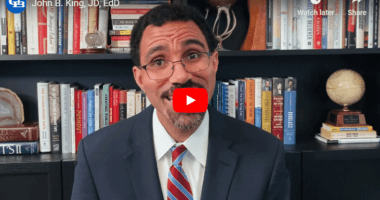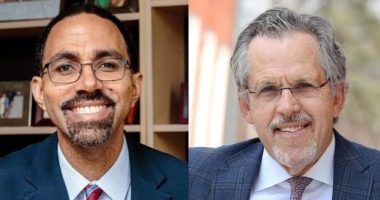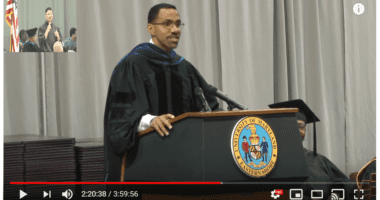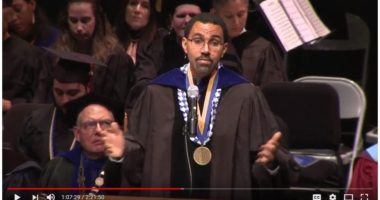John B. King Jr. Speaks at the Silicon Valley Education Policy Summit
On Friday, August 17, John B. King Jr. spoke to the Silicon Valley Leadership Group’s Silicon Valley Education Policy Summit, delivering remarks on the state of education nationwide, from cradle to career.
Thank you to the Silicon Valley Education Policy Summit for inviting me to join you all. Thank you for the opportunity to talk with you about education equity. I also want to save time for the conversation with Kathy so I won’t talk long, but I do want to make a few points to frame our conversation.
One, I am thrilled that the future of work and the linkage between P-12 education, higher education, and the workforce is at the center of our conversation today.
And this is an urgent moment.
Even though we have the lowest unemployment rate we’ve had in a long time as a country, we know there are millions of unfilled jobs. Whenever I go around the country, when I talk with employers, they talk about the challenge of finding the workforce they need. They talk about the challenge of finding folks with the right skills. In fact, Northeastern University did a recent survey of business leaders asking them about college graduates and their readiness for the workforce. Eighty-seven percent of the business leaders surveyed said that their view is that college graduates are arriving underprepared in terms of the jobs that are available. And that was both on the technical skills side, but also on what some people refer to as the “soft skills” side: problem solving, critical thinking, and the ability to collaborate.
That’s worrisome.
It is also worrisome that in those workforce challenges that we have, we see huge equity gaps.
Yes, we have a relatively low national unemployment rate, but when you dig into the numbers, in high-needs community after high-needs community across this country, you can find places where the unemployment rate for African-American and Latino men is a quarter, a third. You can find communities where half the young African-American men are unemployed. Not in school, not at work.
Think about the implications of that for the health and wellbeing of our communities.
I want to argue that education equity is part of the answer to these challenges we face.
Part of why we are where we are—part of why we have 30- to 40-point achievement gaps across state standardized assessments, part of why we see 10- to 20-point gaps in high school graduation rates, part of why we see college completion gaps by race and income—is because too often in this country we still give those students who need the most the least.
We give low-income students and students of color less access to high-quality early learning, even though we know the return on investment for high-quality early education is something like 8 to 1, 9 to 1, in terms of dollars invested.
We then send students on to a K-12 system where students from low-income backgrounds and students of color systematically get less. Less resources. We did a study at The Education Trust that showed, on average across the country, we spend about $1,000 less per student on high-needs children than we spend on affluent children. Exactly backwards. And we know in many places that gap is wider.
We know that students in our K-12 system who are most in need often have less access to effective teachers; less access to a well-rounded education that includes science, social studies, and the arts; less access to school counselors.
We did a study when I was at the U.S. Department of Education that showed we have 1.6 million students who go to a high school where there is a sworn law enforcement officer, but no school counselor. Think about the implications that has. Think about what message that sends to young people about what we expect from them and for them.
Often in our K-12 system, students from low-income backgrounds and students of color also have less access to advanced coursework.
Through the Civil Rights Data Collection at the Education Department, we learned that students from low-income families and students of color are more likely, significantly more likely, to attend high schools where you can’t even take chemistry, or physics, or calculus, or even Algebra II. We say we want a STEM workforce ready for STEM jobs and yet we have students who go to schools where they can’t even take chemistry or physics.
Then we know in our colleges and universities, too often, the students who have gone to the highest needs K-12 schools end up in higher education institutions that are systematically under resourced.
And as a country, we’ve chosen over the last 30 years to invest at a much faster rate in prisons than in higher education. In fact, over the last three decades, spending on public higher education in many states has stayed flat while in many places spending on prisons has doubled. Think about that. Think about the choices that those actions reflect.
So that’s part of how we got here, the question is what will we do about it?
I hope that’s where our conversation will focus.
I want to suggest two things.
One, partnerships among K-12, higher ed, and the business community are critical for getting to a better place. We have to help young people see the relationship between what they are doing in school and their long term future.
We have lots of promising examples around the country.
There are initiatives such as the Urban Alliance, which runs programs in Washington, D.C., and Chicago where students get internships while in high school, after school, and in the summer. Students also receive a mentor from their employer partner. And what the Urban Alliance has shown is that students who have those internship experiences and those work readiness experiences are not only more likely to graduate from high school, they’re more likely to go on to college. It’s not about college or careers, it’s college and careers.
We also have promising examples such as the PTECH School in New York City, a partnership among IBM, the City University of New York, and the New York City Department of Education. When students graduate from PTECH, they graduate with a high school diploma, an associate’s degree, and they are first in line for a job at IBM. When I was working as state commissioner in New York, we were able to scale that up. We were able to grow the PTECH initiative across the state. We had more demand from employers and higher education institutions than we could fill. So many folks were eager to strengthen those connections.
So that’s part of the solution, but also part of the solution is that all constituencies—educators, parents, communities, civil rights organizations, the business community—have to work together on the policy changes that are essential to produce equitable educational opportunity.
We should have universal access to high-quality preschool. Not just for 4-year olds, but for 3-year-olds. It is doable. There are communities all over the country that are working toward that goal.
We could do that together, that’s a policy agenda.
Our policy agenda has to include that ensuring that every child has access to a highly effective teacher and that our teacher workforce is diverse.
Today, a majority of the kids in the nation’s public schools are kids of color. Only 18 percent of our teachers are teachers of color; only 2 percent of our teachers are African-American men. Increasing the diversity of the teacher workforce is important for all students; students of color need to see folks who look like them in the classroom and in leadership roles in the school.
But I’d argue it’s also important for White students to see teachers of color and principals of color in leadership roles in the community. That’s a policy agenda.
We need a policy agenda around attracting folks to teach STEM subjects in particular.
We have a desperate need for high school math and science teachers, including teachers who are well-trained to work with students with disabilities and students who are English learners. We ought to be investing, as do our international competitors, in teacher preparation, in teacher compensation, in teacher career ladders that give teachers leadership opportunities.
So we need those partnerships, but we also need a policy agenda focused on equity.
The last thing, and then we can turn to the conversation, is that we need to stay hopeful. Hopeful.
How many folks in this room, as the first thing you did this morning, turned on cable TV or checked your news alerts on your phone? I would suspect that for many of us, that was not a hopeful moment—whatever we saw on cable TV or whatever we encountered when we checked in on Twitter.
Despite that, at the end of the day, education is at the foundation of the long-term health and wellbeing of our democracy. So we have to stay hopeful and we have to stay focused on how we can expand opportunity through education.
I always say to folks, there is no problem we face in public education that can’t be solved by what’s right about public education. Somebody somewhere is solving literally every problem we face. The question is, how do we take that to scale?
I’m hopeful because the evidence supports the fact that there are promising practices happening all over the country, but I’m also hopeful because of my own experience.
I stand here today, I’m alive today, because of the New York City public school teachers who saved my life.
I grew up in Brooklyn. Both my parents spent their entire careers working for the New York City public schools. My father was African-American, born just after the turn of the 20th century in segregated New York City. My mother was born in Ponce in Puerto Rico, came to the Bronx as a child, learned English in school, went to City University of New York, a classic Nuyorican story, and became a teacher.
Both my parents passed away when I was a kid; my mom when I was 8, my dad when I was 12.
After my mom passed, I lived with my dad, who was sick with undiagnosed Alzheimer’s disease. So home was this place that was scary and inconsistent and unstable. I recall one night when I was awakened by my father at two in the morning. I remember being on the staircase of our house as my father was pulling me down the stairs saying, “It’s time to go to school.” I remember arguing with him and saying, “No daddy; it’s not time to go to school. It’s the middle of the night.” And I remember not understanding why he thought it was time to go to school and why this was happening. That’s what home was like.
As my father got more and more sick, I took on more and more responsibility.
I’d get food. I’d pay bills. And I figured out how to keep our household going.
But the thing that saved me was as series of phenomenal New York City public school teachers who made school a place that was safe and engaging and interesting. I had a teacher in fourth, fifth, and sixth grades, Mr. Osterweil. He had us read the New York Times every day. I always say he was doing college- and career-ready standards before we called them college- and career-ready standards. We read The New York Times every day … in fourth, fifth, and sixth grade.
We put on productions of A Midsummer Night’s Dream—Shakespeare in elementary school. We did a production of Alice in Wonderland. I was the rose in Alice in Wonderland. Imagine me with big, red felt petals sticking out of my head. In Mr. Osterweil’s class we went to the museum and the ballet; and he just showed us this whole world of possibility beyond Canarsie, Brooklyn. If I hadn’t had Mr. Osterweil as my teacher in fourth, fifth, and sixth grades, I wouldn’t be alive today I’m quite certain of that.
And it wasn’t a straight line. By the time I got to high school, I was moving around between family members and schools. I got in trouble a lot—as many young people who we work with, do. Young people who have experienced trauma often struggle with authority. I did. I got in trouble all the time. I got in trouble so much, I got kicked out of high school.
I always say I’m the first U.S. Secretary of Education ever to have been kicked out of high school. But I share that partly to say that I hope I’m not the last. Right? Because part of why I’m standing here is because I had these great teachers who saved me, who sustained me through elementary school and middle school. Then I had another set of teachers and a counselor and some family members and some mentors who, even after I made mistakes, believed in me more than I believed in myself. They were willing to give me a second chance. It is because of that second chance that I am standing here today.
I share this story with you to say that schools save lives. Teachers, principals, every day, save kids’ lives.
They don’t even know it sometimes. Mr. Osterweil had no idea what was going on at home for me. He saved my life because he made class great. That’s what’s at stake. That’s why this work matters. That’s why we stay hopeful.
I bet every person in here has a story about a teacher, a principal, an educator who inspired them.
That’s why we stay hopeful because we know what’s possible for every kid. That’s why we’re here. That’s why we’re talking about education equity.
Thanks for the opportunity to join you; I look forward to the conversation.









